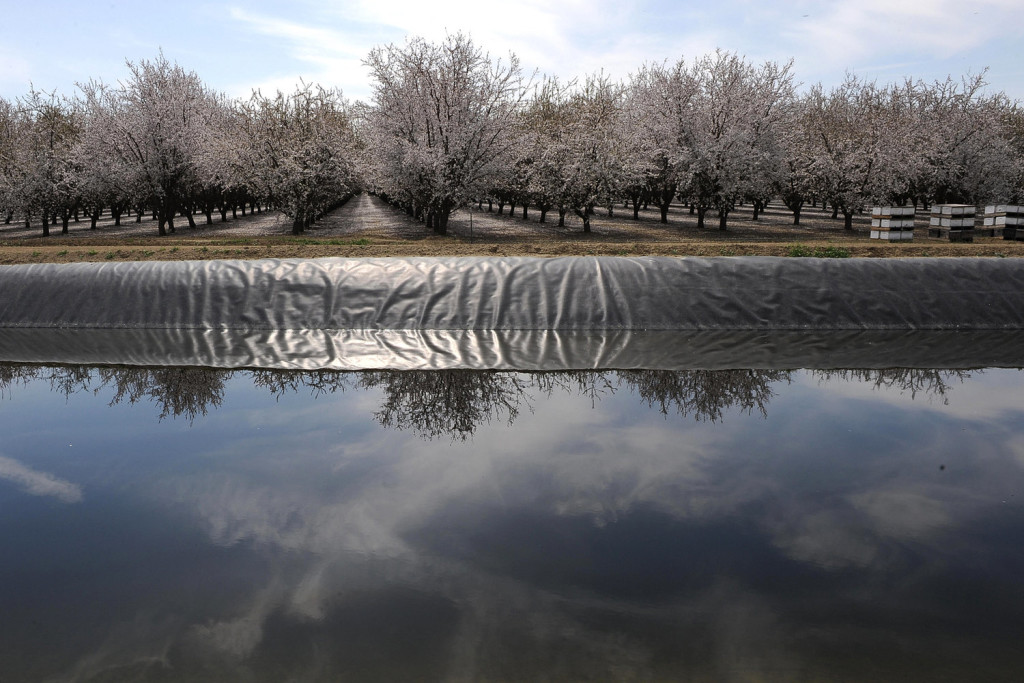Tragedy of the Commons–California Drought-Style
Legal Planet: Environmental Law and Policy 2015-07-14

Traveling through California’s drought-striken San Joaquin Valley repeatedly over the past year, I’ve been surprised and disheartened to see that Valley farmers continue to convert their agricultural fields to newly-planted almond orchards. (My anecdotal observations have been confirmed by various recent press accounts.) This development is a striking, current example of Garrett Hardin’s Tragedy of the Commons.

Garrett Hardin, 1986 (The Garrett Hardin Society)
Hardin was an ecologist and microbiologist whose most famous work is his 1968 essay, “The Tragedy of the Commons,” first published in the journal Science. (I was privileged to take a course in Human Ecology from Hardin–one of the early environmental “rock stars”–when I was a student, and he a professor, at U.C. Santa Barbara in 1969.) “The Tragedy of the Commons” focuses on how individually rational economic decisions can lead to environmental ruin. Using an example from early 19th century, agrarian England, Hardin’s essay focuses on herders sharing a common parcel of land on which each is allowed to graze their sheep. While overgrazing of the “commons” inevitably leads to the depletion/destruction of the parcel, each individual herder finds it in his/her economic interest to add an extra sheep or two to graze on the commons. Thus can individually rational actions work to the detriment of all by destroying resources held in common.
Hardin, of course, was making a larger point about the perils of overpopulation and private exploitation of finite environmental resources, including the Earth’s oceans and atmosphere.
Fast forward to 2015. California is facing the worst drought in recorded state history. All of California’s 39 million residents are experiencing the deleterious effects of that drought to one extent or another, and the state’s agricultural sector is no exception. Indeed, San Joaquin Valley farmers are suffering to a greater extent than their counterparts in, e.g., the Sacramento and Imperial Valleys, due to the former’s relatively junior water rights and their dependence on state and federal water projects that have cut back dramatically on water deliveries due to the drought.
One might think that this is a time when San Joaquin farmers would logically focus on their traditional agricultural operations, conserving where possible and fallowing their fields when necessary. Not so, apparently. More and more San Joaquin farmers and landowners are converting their row crop acreage to newly-planted almond orchards–even in the face of unprecedented, statewide water shortages.
In terms of pure economic terms, this conversion makes perfect sense: almonds are a far more lucrative crop than are the relatively low-value row crops–like cotton and alfalfa–that they have generally replaced. (One key problem with this trend is that farmlands committed to row crops can be fallowed in time of drought, while almond orchards cannot. Orchards require a continuous supply of water in dry and wet years alike; otherwise, a farmer’s expensive investment in his or her orchard is wiped out.)
But planting new almond orchards in the midst of a terrible drought makes absolutely no sense when it comes to the broader public interest and the state’s environment. Doing so simply makes the aggregate demand for finite water resources that much greater. And, according to climate scientists, there’s a good chance that chronic shortages will represent the “new normal” of California’s long-term water future. By maximizing their individual revenues, these almond growers are helping to destroy the 21st century “commons” that is California’s shrinking water supply.

A field of almond trees is reflected in an irrigation canal in Firebaugh, Calif., in the San Joaquin Valley in 2009. Robyn Beck/AFP/Getty Images
One might well ask where San Joaquin almond growers are obtaining the water needed to irrigate their newly-planted orchards, given the well-documented cutbacks in water deliveries from the State Water Project and (federal) Central Valley Project. The answer in most cases is: groundwater. In the San Joaquin Valley, agricultural interests have pretty much unfettered ability to drill and pump from new groundwater wells, despite the fact that parts of the Valley have suffered dramatic subsidence, groundwater contamination, and groundwater basin overdraft. One of the shortcomings of California’s 2014 state groundwater legislation is that the new law does absolutely nothing to curb such current practices, focusing instead on preparation of long-term “groundwater sustainability plans” that won’t take effect for many years.
So whether the “commons” affected by the recent profusion of new almond orchards is viewed as California’s overtaxed groundwater resources or the state’s water supply generally, this growing phenomenon is, indeed, a tragedy. It’s one that calls for prompt remedial action by state political leaders and water regulators.